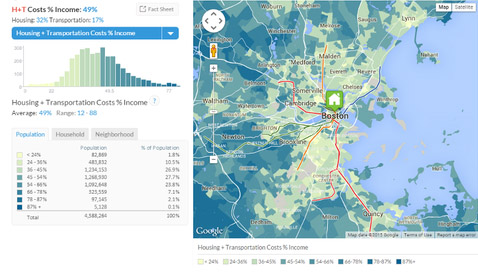
Furthering Fair Housing Through Equitable Transit-Oriented Development
New HUD Rules Emphasize Fair Housing and Better Access to Transit and Jobs At a press conference in Chicago today, HUD Secretary Julian Castro announced new rules nationwide aimed to help cities build inclusive communities near transit and jobs, with good schools and a high quality of life. Those rules, titled Affirmatively Furthering Fair Housing (AFFH), ask communities receiving HUD funding to demonstrate how they are using their investments to proactively create communities... Continue reading »
Now is the Time to Fund Cook County’s Transit Future
The past few weeks have proven to be a pivotal few for the Transit Future campaign and, indeed, for the future of transit in Cook County. On the evening of June 18th, Congressman Mike Quigley joined us in Chicago to show his support for transit expansion, addressing a room full of elected officials, business leaders, and other Transit Future supporters. Quigley, who serves on the Transportation, Housing and Urban Development, and Related Agencies appropriation committee, shared... Continue reading »
New HUD Rules Can Further Fair Housing Through Equitable Transit-Oriented Development
Communities need good access to jobs and transit Today, HUD Secretary Julian Castro introduced new nationwide rules in Chicago that will provide guidance to help cities fulfill the 1968 Fair Housing Act by promoting racially integrated neighborhoods with access to transit, jobs, and schools. The Center for Neighborhood Technology (CNT) supports these new rules and we agree with Sec. Castro that for far too long federal efforts have fallen short, said Jacky Grimshaw, Vice President... Continue reading »
CNT calls for Illinois elected leaders to help victims of urban flooding
New state study finds 92% of flood damage claims are from homeowners and businesses outside floodplains SPRINGFIELD – Illinois experienced the wettest June in recorded history as we continue to see an increase in the frequency and intensity of rain events nationwide. This has resulted in more and more flooded homes and businesses, bringing with it the associated costs of property damage, negative health impacts, loss of work time and a significant loss in property value. A new... Continue reading »
CNT Applauds SCOTUS Ruling that Supports Diverse Communities with Access to Jobs
The Center for Neighborhood Technology (CNT) applauds the U.S. Supreme Court for upholding disparate impact liability in the case of Texas Department of Housing and Community Affairs v. Inclusive Communities Project. The Court ruled that the Fair Housing Act prohibits policies that adversely affect minority groups and reinforce segregation, even when such outcomes are an unintended consequence. At the center of the case was whether Low-Income Housing Tax Credits should be allocated to the... Continue reading »
CNT President Scott Bernstein’s Statement on SCOTUS Decision on Fair Housing Act
CNT applauds the U.S. Supreme Court for upholding disparate impact liability in the case of Texas Department of Housing and Community Affairs v. Inclusive Communities Project. The Court ruled that the Fair Housing Act prohibits policies that adversely affect minority groups and reinforce segregation, even when those actions are not a stated goal. “At the center of the case was whether Low-Income Housing Tax Credits should be allocated to the inner city or in the suburbs,” CNT’s president and... Continue reading »
Millennials Don't Need All That Parking Space
Who would have thought that the hottest topic in planning circles would ever be parking? For generations, we planned our cities for cars first and people second. Now the tide is turning. Cities across the country are focusing on walking and cycling, on transit-oriented development (TOD), and on figuring out the appropriate place and space for parking. It’s all tied to generational shift. Millennials simply don’t want to drive like their parents did. As consumers, they gravitate... Continue reading »
CNT’s Kyle Smith Wins Urban Land Institute Young Visionary Award
We’re proud to announce that Kyle Smith, CNT’s Economic Development Project Manager, is a winner of the Urban Land Institute Chicago’s Young Visionary award. Through his work at CNT, Kyle has helped shape regional policy priorities to encourage smart land use that benefits communities and strengthens local markets. One of his seminal achievements thus far has been getting key agency stakeholders, mayors, and developers to embrace Priority Development Areas (PDAs). He first recommended PDAs... Continue reading »
Solving Neighborhood Problems Through Technology
An app connecting grocers to budget-conscious consumers, encouraging them to work together to prevent food from going to waste, was the big winner in the 4th annual CNT Urban Sustainability Apps Competition held last weekend. The competition connects community members and coders to solve real neighborhood problems using mobile technology. This year, the products designed were more sophisticated than ever, thanks in large part to the increased mentorship and opportunities to begin working... Continue reading »
Quigley, Durbin Lead Bicameral Push to Address Urban Flooding
WASHINGTON – Today, U.S. Representative Mike Quigley (IL-05) and U.S. Senator Dick Durbin (D-IL) introduced the bicameral Urban Flooding Awareness Act to address increased flooding in urban communities and to find solutions for the urban communities impacted. “Flooding is not just a coastal issue. In recent years, cities, like Chicago, have experienced unprecedented flooding events. While emergency programs provide relief for families and businesses in traditional flood areas, those... Continue reading »





 Strengthening Transit Through Community Partnerships
Strengthening Transit Through Community Partnerships








